
How Stephen Gould Scaled Its Capacity by 30% without Making a Single Hire

We gathered the top 7 email marketing key performing indicators (KPIs) to help you measure the effectiveness of your email marketing campaigns.
Executive Summary:
We gathered the top 7 email marketing key performing indicators (KPIs) to help you measure the effectiveness of your email marketing campaigns.
As other digital marketing channels and strategies evolve, email remains the core marketing channel for various brands of all kinds of industries. Creating a powerful email marketing strategy can have a significant impact on your overall marketing strategy success and business growth.
But how do you measure the success of your email marketing efforts? There are some important metrics that you must be measuring as often as possible to make sure that you are doing it right and improve the ROI of your email campaigns.
In this article, we’ll show you how to measure your email marketing effectiveness, what are the benefits of email marketing, what are the best and worst days to send emails, and finally present you with the email marketing best practices how to improve your email marketing performance.
But first:
Email marketing is a digital marketing channel that uses email to promote your business’s products or services. It is a powerful strategy that helps converting leads into paying customers and increases the retention of existing customers.
There are many types of email marketing emails including email newsletters, welcome emails, lead nurturing emails, transactional emails, and more. They all have a different goal to achieve, but commonly their purpose is to build loyalty, trust, or brand awareness.
Traction’s authors Gabriel Weinburg and Justin Mares say: ‘’ Email marketing is one of the best ways to convert prospects while retaining and monetizing existing customers. It can be used at all stages of the customer lifecycle: to acquire customers, build familiarity with prospects, move customers through your funnel, and retain the customers you already have. There are many legitimate ways to acquire customers using email.’’
Here are a few reasons why email marketing is such an important traction channel:
Email marketing comes with plenty of benefits for businesses. It’s one of the most successful and effective ways to advertise your business, increase brand awareness, and generate conversations and sales. Keep on reading to find out more about the benefits of email marketing and why your business should incorporate is as part of its overall marketing strategy asap.
There is no other marketing channel with a wider reach than email marketing. According to Statista‘s survey, the number of active email users has reached 4 billion in 2020 and is set to grow to 4.6 billion users by 2025. That is more than half of the world’s population! Think of how many people around the world your business can reach via email.
Just as a comparison, in 2020, the most popular social media channel Facebook reached 2.6 billion active users.
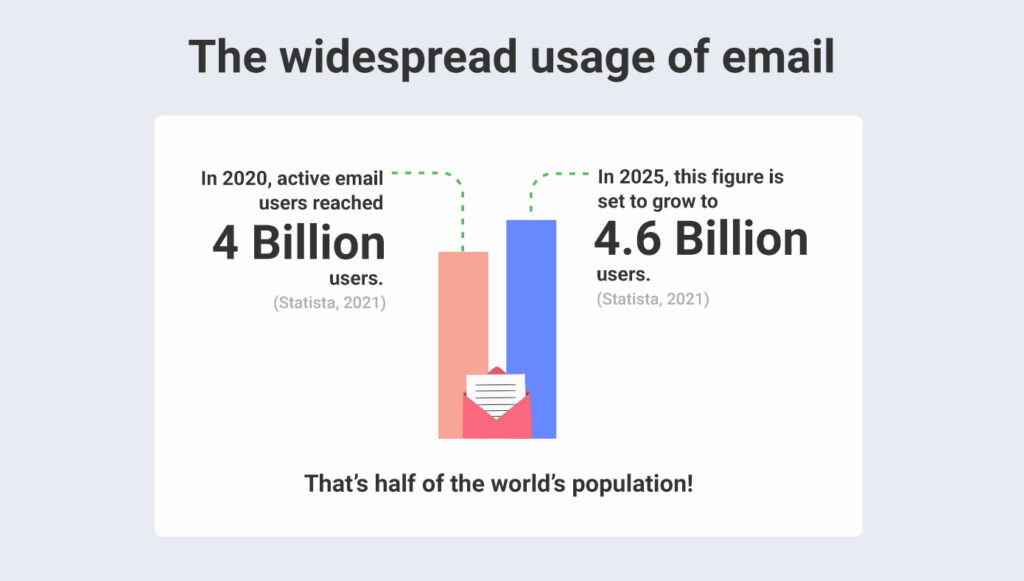
Marketing Sherpa found that the majority of customers want to receive promotional emails. 86% would like to receive emails at least monthly, while 15% would like to receive promo emails every single day.
Unlike social media where people communicate with friends and family on a personal level, email is a more professional medium where users expect to receive information about products and services that they are interested in.
The cost of email marketing can be much lower compared to other marketing channels. There are no advertising fees, no print or postage costs (here’s another benefit of email marketing – it’s also environment friendly!), or paying for a tv commercial or billboard placement.
The only cost around email marketing is investing in email marketing software that can automate, track, and evaluate your emails, as well as keeping your email lists, and investing in email marketing specialists who knows all email marketing best practices and tricks to grow your customers and profit.
The most important benefit of email marketing is that it is the marketing channel that delivers the biggest ROI for your company. Campaign Monitor reports that for ten years in a row, for every $1 spent, email marketing generates $38 in ROI. That is an average of 3,800% return on investment for businesses.
The reason for this is that email marketing allows marketers to send highly personalized and targeted emails. You can also segment your email list and only send emails to subscribers that meet certain criteria.
It is no surprise that email marketing is the number 1 preferred channel for marketers.
Another key benefit of email marketing is that it’s easy to measure what you are doing right and where you are going wrong with your campaigns. In the following section of our article, we will show you exactly what metrics you can measure and how.
So, how to measure whether your email marketing strategy delivers the desired results? We gathered the top 7 email marketing key performing indicators (KPIs) to help you measure the effectiveness of your email marketing campaign and whether they hit your goals:
Your email open rate is one of the most important metrics to keep track of. It is one of the best ways to tell whether your email marketing strategy is working by showing you the percentage of your audience that opens the emails you are sending them. There are a couple of factors that can affect your open rate such as the subject line and the sender’s name.
How to calculate your open rate: Divide the number of open emails by the number of total recipients and multiply the outcome by 100.
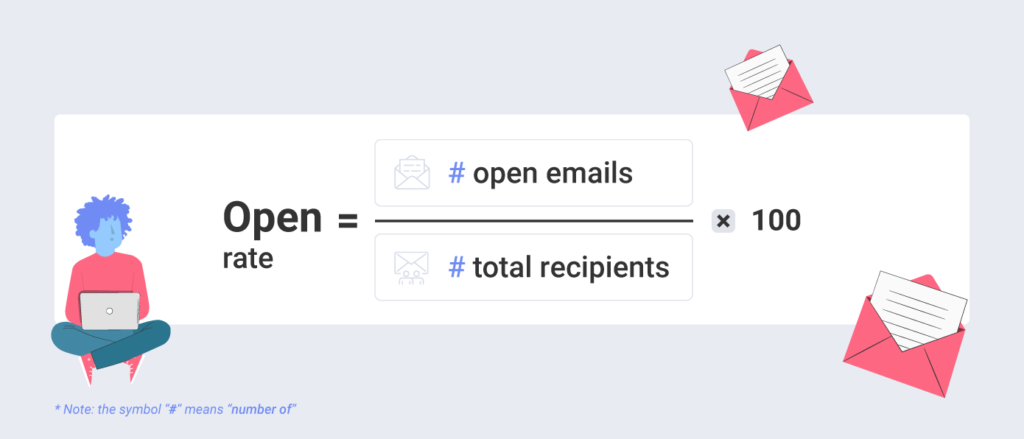
For example, if you send out 100 emails and only 45 of them get open, your open rate is then 45 / 100 = 0.45. You multiply that by 100 and you have an email open rate of 45%.
The click-through rate is one of the key email marketing KPIs. The goal of almost every marketing email is to get the subscribers to take action – click on a link that it’s inside the email that often leads to a landing page where the subscribers can buy a product or service or drive traffic to your website.
So, when it comes down to measuring the effectiveness of your email marketing, the click-through rate is a metric that email marketers should keep their eyes on. It shows the percentage of email recipients who clicked on a link inside your email.
How to calculate your click-through rate: Divide the number of people that have clicked on the link in your email by the number of emails that were successfully delivered and multiply the outcome by 100.
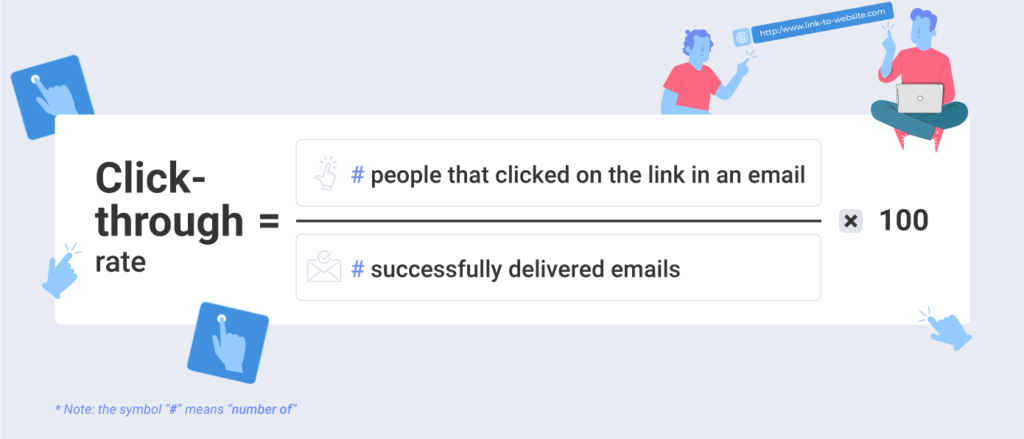
For example, if you send out 100 emails and 37 people click on the link within your email, your click-through rate is then 37 / 100 = 0.37. You multiply that by 100 and you have an email click-through rate of 37%.
The factors that affect your email click-through rate include your anchor text, the position of the link within the body of the email, the copy that leads to your link, having a clear and compelling CTA, as well as responsive design.
This email marketing KPI determines whether your content resonates with your recipients. It differs from the click-through rate because it is based on people who opened your email rather than your entire recipient list.
How to calculate your click-to-open-rate: Divide the number of unique clicks by the number of unique opens and multiply the outcome by 100.
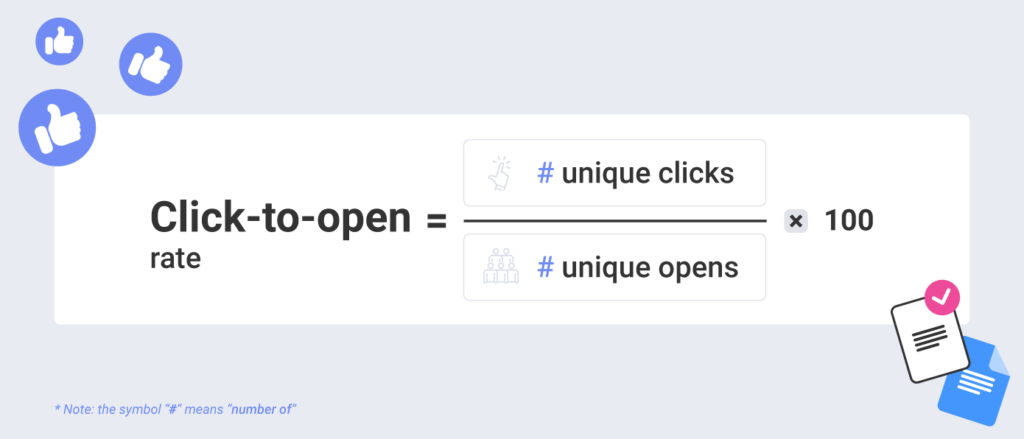
For example, if your email receives 30 clicks and 45 opens, your click-to-open rate is then 30 / 45 = 0.66. You multiply that by 100 and you have an email click-to-open-rate of 66.66%.
But what is the difference between opens and unique opens, and clicks and unique clicks?
For example, if your email is opened by the same subscriber 7 times, that would count as 7 total opens and 1 unique open.
For example, if a subscriber clicks 5 times on a link, this counts as 5 total clicks and 1 unique click.
Bounced emails are sent emails that weren’t successfully delivered to your recipient’s inbox. Emails can bounce due to a couple of reasons and fall under two categories:
How to calculate your email bounce rate: Divide the number of bounced emails by the number of emails you have sent and multiply the outcome by 100.
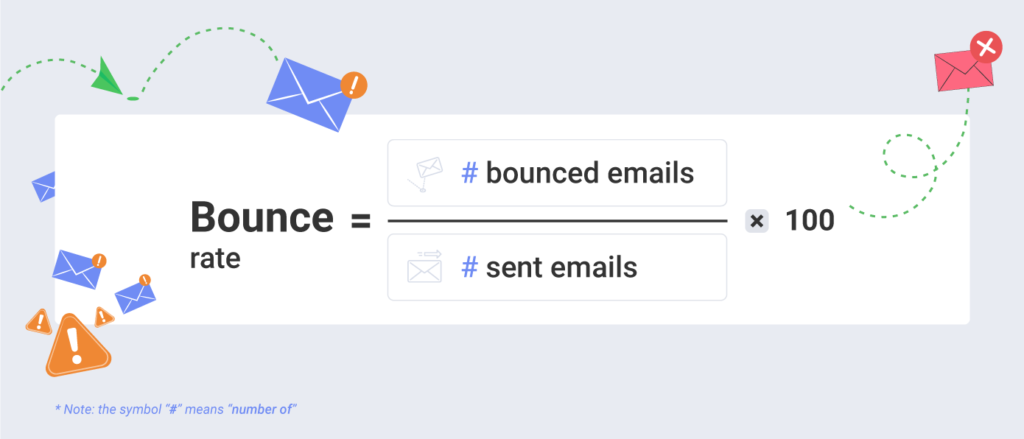
For example, if you have sent 100 emails and 8 of them bounced back, your bounce rate is then 8 / 100 = 0,08. You multiply that by 100 and you have an email bounce rate of 8%.
The conversion rate is also a very important email marketing KPI for marketers as it indicates how effective is your email marketing campaign is and determines your ROI. It shows the percentage of subscribers who took your desired action after reading your email. An example of such an action is getting the subscriber to a landing page where the subscriber will fill out a lead form.
How to calculate your email conversion rate: Divide the number of recipients who took the action you wanted by the number of emails you have sent and multiply the outcome by 100.
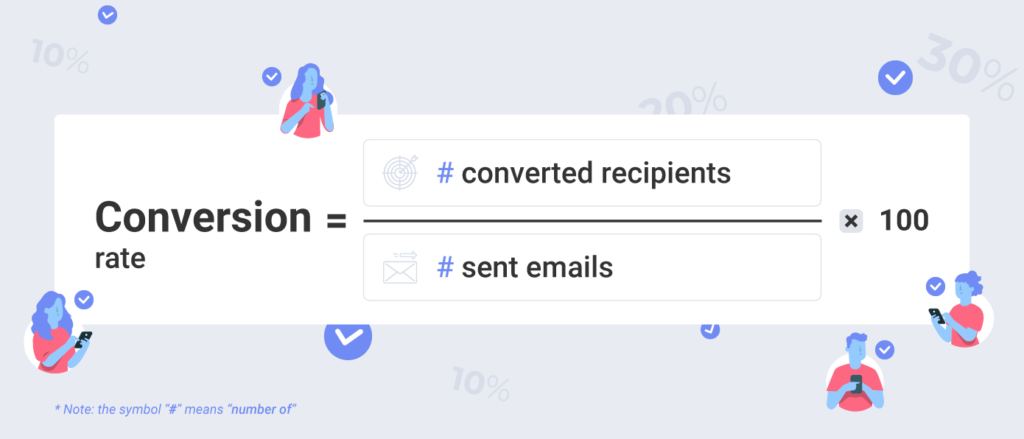
For example, if you have sent 100 emails and 26 people took the action you wanted them to, your conversion rate is then 26 / 100 = 0,26. You multiply that by 100 and you have an email conversion rate of 26%.
The list growth rate is the rate at which your email list has grown over a certain period of time.
How to calculate your email list growth rate: Divide the number of new subscribers – the number of unsubscribes by the total number of email addresses on your list and multiply the outcome by 100.
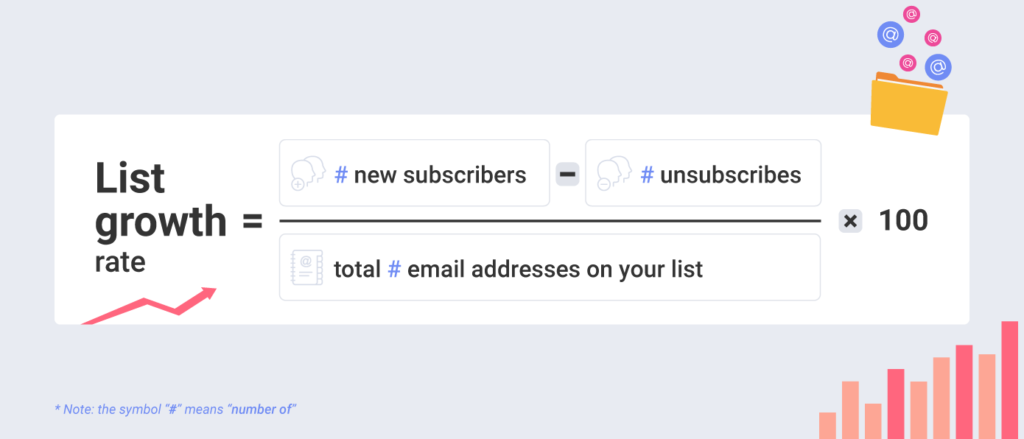
For example, if you have 50 new subscribers, 10 unsubscribes and an email list of 400, your list growth rate is then 50 – 10 / 400 = 0,1. You multiply that by 100 and you have an email list growth rate of 10%.
The unsubscribe rate is the percentage of your email subscribers who decided that they don’t want to receive emails from you any longer.
How to calculate your email unsubscribe rate: Divide the number of people who have unsubscribed from your email list by the total number of emails that got delivered and multiply the outcome by 100.
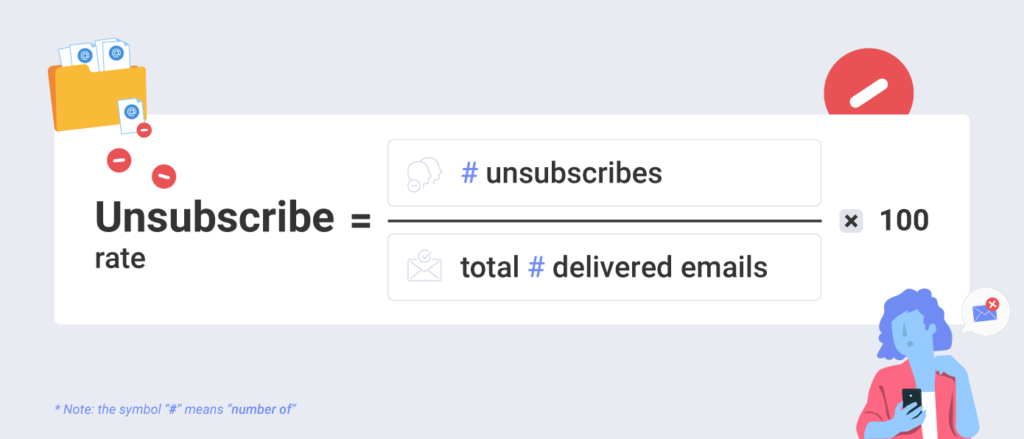
For example, if you have sent 100 emails and 5 people unsubscribed from your email list, your unsubscribe rate is then 5 / 100 = 0,05. You multiply that by 100 and you have an email unsubscribe rate of 5.
Let’s go back to the open rate. After you already know how important it is and how to calculate it, you are probably wondering what is a good open rate for email marketing.
It is a tricky question. According to Smart Insights, the average email open rate is 16.97%, but the average email open rate varies dramatically from one industry to another.
Still, there are many studies out there that can give us an idea of what to expect:
While looking at the average across all industries see how you are stacking up against the benchmarks for your specific industry:
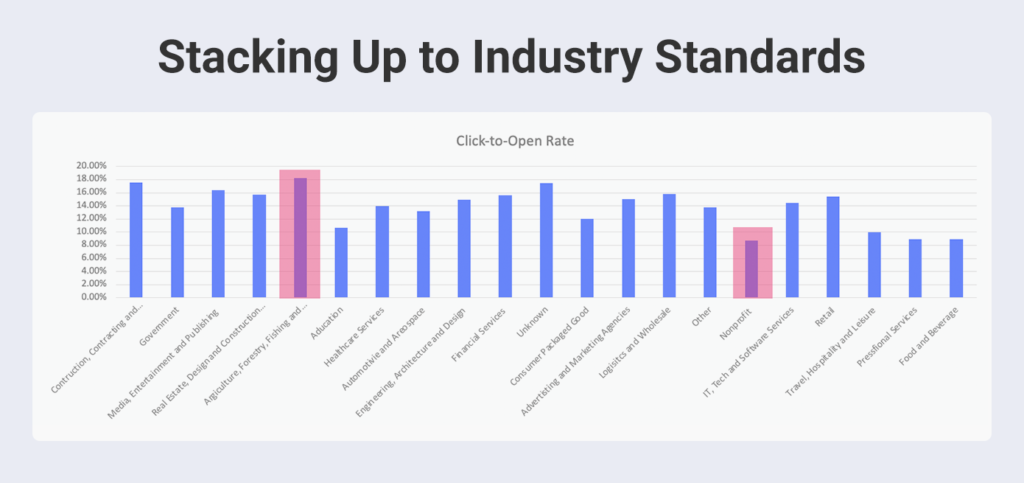
One of the most frequently asked questions related to email marketing is: What is the best time to send emails? Which day of the week and at what time?
So, is there a perfect time to send emails?
The truth is that there is no perfect time. We are sorry to break it to you, but what works for others doesn’t necessarily mean that it would work for you too. There are tons of studies trying to answer this question and while some of these studies are in agreement, others are completely contradictory.
Every email list is made up of a different set of people, with different interests and habits. So, what should you do to find out what is the best time to send emails is to test what would work best for your own audience.
But if you are just starting out with email marketing it is important for you to have a place to start. For the purpose of this article, we relied on data about the best days to send marketing emails from Campaign Monitor. That is what they have found:
Best days for email marketing:
Worst days for email marketing:

To come up with these statistics, Campaign Monitor analyzed over 100 billion emails sent globally between January and December 2020
You can use this information to test your sending times and find out what is the perfect time to send emails to your specific audience.
You already know the best days to send marketing emails, as well as the worst, and that you should test your sending times to find out what is the perfect time to send emails to your specific audience. So, when you find which days your audience engages the most with your emails, then those are your highest-performing days when you have to send your emails.
Sending the same message to your entire email list may work from time to time, but if you want to generate sales email list segmentation is the way to go.
Email list segmentation is a technique that email marketers use to divide their subscribers into smaller segments based on set criteria such as location, purchase history, interest, gender, income, education, employment, and more.
Email segmentation is used as a tactic to deliver more relevant content to your email subscribers. You want your email marketing campaign to deliver the right message to the right people at the right time and this is what makes email segmentation a must.
IBM’s 1028 Marketing Benchmark Report found that up to 60% of email opens will occur on mobile devices, depending on the industry.
That means that regardless of your industry, a lot of your subscribers will open and view your emails from their mobile devices. For this reason, you need to create mobile-first or responsive designs for their emails.
Here are a couple of things to keep in mind:
Personalization is one of the best email marketing best practices. Having your email coming from a person instead of a generic email helps build a relationship with your subscribers. People want to receive emails and interact with other people and not mailboxes.
An interesting fact is that studies have shown that trusting the sender is the single most important factor in whether an email is opened or not.
Your “from’’ name and email address have to be recognizable to your subscribers, like your company name for example.
The main goal of your email subject line is to compel your subscribers to open your email and read it. The best subject lines communicate the promise of value. Your email subject line must convince your subscribers that the email that you are sending them contains information that will be of value to them or their business.
In fact, those that don’t accurately tell what you are going to find inside are often reported as spam.
Here are some tips on how to write compelling subject lines:
And last, but not least of our email marketing best practices is having a clear and compelling call to action (CTA). A CTA is a phrase that is used to tell the subscriber what action to take – learn more, buy now, start a free trial, etc.
The CTA is usually in the form of a button because buttons are eye-catching and clean.
To create a powerful email CTA, you should first define your goal, then write your copy and finally design your CTA button. A successful CTA is more than a bright button with a catchy text that functions independently, but instead, a CTA that works is part of the entire copy of your email. Every element of your email contributes to making your CTA work and drive better conversions.
Email marketing is not rocket science, you just have to do it right. Knowing how to measure the effectiveness of your email marketing campaigns, being aware of the email marketing best practices, and finding the best days to send marketing emails will help you skyrocket your overall marketing strategy.
Now it’s your turn. Go ahead and check your email marketing performance right now. How effective is your email marketing? How will you apply what you have learned from this article to your own campaigns?
SHARE THIS POST